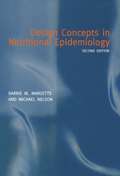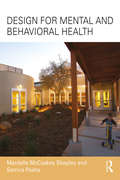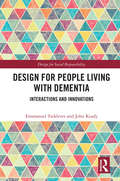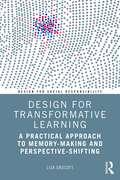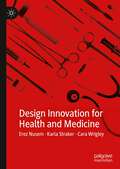- Table View
- List View
Design Concepts in Nutritional Epidemiology
In examining the relationship between nutritional exposure and disease aetiology, the importance of a carefully considered experimental design cannot be overstated. A sound experimental design involves the formulation of a clear research hypothesis and the identification of appropriate measures of exposure and outcome. It is essential that these variables can be measured with a minimum of error, whilst taking into account the effects of chance and bias, and being aware of the risk of confounding variables. The first edition of Design Concepts in Nutritional Epidemiology presented a throrough guide to research methods in nutritional epidemiology. Since publication of the 1st edition, we now have a much better understanding of the characteristics of nutritional exposure that need to be measured in order to answer questions about diet-disease relationships. The 2nd edition has been extensively revised to include the most up-to-date methods of researching this relationship. Included are new chapters on qualitative and sociological measures, anthropometric measures, gene-nutrient interactions, and cross-sectional studies. Design Concepts in Nutritional Epidemiology will be an essential text for nutritionists and epidemiologists, helping them in their quest to improve the quality of information upon which important public health decisions are made.
Design Controls for the Medical Device Industry
by Marie B. Teixeira Marie Teixeira Richard BradleyThe second edition of a bestseller, Design Controls for the Medical Device Industry provides a comprehensive review of the latest design control requirements, as well as proven tools and techniques to ensure your company's design control program evolves in accordance with current industry practice. The text assists in the development of an effectiv
Design Controls for the Medical Device Industry, Third Edition
by Marie B. TeixeiraThis third edition provides a substantial comprehensive review of the latest design control requirements, as well as proven tools and techniques to ensure a company's design control program evolves in accordance with current industry practice. It assists in the development of an effective design control program that not only satisfies the US FDA Quality Systems Regulation (QSR) and 13485:2016 standards, but also meets today's Notified Body Auditors' and FDA Investigators' expectations. The book includes a review of the design control elements such as design planning, input, output, review, verification, validation, change, transfer, and history, as well as risk management inclusive of human factors and usability, biocompatibility, the FDA Quality System Inspection Technique (QSIT) for design controls, and medical device regulations and classes in the US, Canada, and Europe. Practical advice, methods and appendixes are provided to assist with implementation of a compliant design control program and extensive references are provided for further study. This third edition: Examines new coverage of ISO 13485-2016 design control requirements Explores proven techniques and methods for compliance Contributes fresh templates for practical implementation Provides updated chapters with additional details for greater understanding and compliance Offers an easy to understand breakdown of design control requirements Reference to MDSAP design control requirements
Design Controls for the Medical Device Industry, Third Edition
by Marie B. TeixeiraThis third edition provides a substantial comprehensive review of the latest design control requirements, as well as proven tools and techniques to ensure a company's design control program evolves in accordance with current industry practice. It assists in the development of an effective design control program that not only satisfies the US FDA Quality Systems Regulation (QSR) and 13485:2016 standards, but also meets today's Notified Body Auditors' and FDA Investigators' expectations. The book includes a review of the design control elements such as design planning, input, output, review, verification, validation, change, transfer, and history, as well as risk management inclusive of human factors and usability, biocompatibility, the FDA Quality System Inspection Technique (QSIT) for design controls, and medical device regulations and classes in the US, Canada, and Europe. Practical advice, methods and appendixes are provided to assist with implementation of a compliant design control program and extensive references are provided for further study. This third edition: Examines new coverage of ISO 13485-2016 design control requirements Explores proven techniques and methods for compliance Contributes fresh templates for practical implementation Provides updated chapters with additional details for greater understanding and compliance Offers an easy to understand breakdown of design control requirements Reference to MDSAP design control requirements
Design Creativity (Elements of Improving Quality and Safety in Healthcare)
by null Gyuchan Thomas Jun null Sue Hignett null P. John ClarksonDesign creativity describes the process by which needs are explored and translated into requirements for change. This Element examines the role of design creativity within the context of healthcare improvement. It begins by outlining the characteristics of design thinking, and the key status of the Double Diamond Model. It provides practical tools to support design creativity, including ethnographic/observational studies, personas and scenarios, and needs identification and requirements analysis. It also covers brainstorming, Disney, and six thinking hats techniques, the nine windows technique, morphological charts and product architecting, and concept evaluation. The tools, covering all stages of the Double Diamond model, are supported by examples of their use in healthcare improvement. The Element concludes with a critique of design creativity and the evidence for its application in healthcare improvement. This title is also available as Open Access on Cambridge Core.
Design Engineering and Science
by Nam Pyo Suh Miguel Cavique Joseph Timothy FoleyDesign Engineering and Science teaches the theory and practice of axiomatic design (AD). It explains the basics of how to conceive and deliver solutions to a variety of design problems. The text shows how a logical framework and scientific basis for design can generate creative solutions in many fields, including engineering, materials, organizations, and a variety of large systems.Learning to apply the systematic methods advocated by AD, a student can construct designs that lead to better environmental sustainability and to increased quality of life for the end-user at the same time reducing the overall cost of the product development process. Examples of previous innovations that take advantage of AD methods include:• on-line electric vehicle design for electric buses with wireless power supply;• mobile harbors that allow unloading of large ships in shallow waters;• microcellular plastics with enhanced toughness and lower weight; and• organizational changes in companies and universities resulting in more efficient and competitive ways of working.The book is divided into two parts. Part I provides detailed and thorough instruction in the fundamentals of design, discussing why design is so important. It explains the relationship between and the selection of functional requirements, design parameters and process variables, and the representation of design outputs. Part II presents multiple applications of AD, including examples from manufacturing, healthcare, and materials processing.Following a course based on this text students learn to create new products and design bespoke manufacturing systems. They will gain insight into how to create imaginative design solutions that satisfy customer needs and learn to avoid introducing undue complexity into their designs. This informative text provides practical and academic insight for engineering design students and will help instructors teach the subject in a novel and more rigorous fashion. Their knowledge of AD will stand former students in good stead in the workplace as these methods are both taught and used in many leading industrial concerns.
Design, Evaluation, and Translation of Nursing Interventions
by Souraya Sidani Carrie Jo BradenNurse-led intervention research is a core component of the global initiative to improve quality of care. Though research in this area has already contributed much to the advancement of patient care, future strides depend on the dissemination of practical, how-to instruction on this important area of research. Design, Evaluation, and Translation of Nursing Interventions aids in this endeavour by presenting both general approaches and specific methods for developing nursing interventions. Logically organized to facilitate ease of use, the book is divided into four sections. The introduction provides a firm grounding in intervention science by situating it within the broader topics of evidence-based practice, client-centred care, and quality of care. Section Two describes each step of intervention design, including correct identification of the health issue or problem, clarification of the elements comprising an intervention, and application of theory. Section Three is centred on implementation, highlighting such topics as development of the intervention manual, training interventionists, and intervention fidelity. The book concludes with methods to evaluate interventions enacted and suggestions for their translation into practice. Design, Evaluation, and Translation of Nursing Interventions distills the authors’ years of expertise in intervention research into comprehensive, easy-to-follow chapters. It is a must-have resource for students, researchers and healthcare professionals wishing to impact the future of patient care.
Design, Evaluation, and Translation of Nursing Interventions
by Souraya Sidani Carrie Jo BradenNurse-led intervention research is a core component of the global initiative to improve quality of care. Though research in this area has already contributed much to the advancement of patient care, future strides depend on the dissemination of practical, how-to instruction on this important area of research. Design, Evaluation, and Translation of Nursing Interventions aids in this endeavour by presenting both general approaches and specific methods for developing nursing interventions. Logically organized to facilitate ease of use, the book is divided into four sections. The introduction provides a firm grounding in intervention science by situating it within the broader topics of evidence-based practice, client-centred care, and quality of care. Section Two describes each step of intervention design, including correct identification of the health issue or problem, clarification of the elements comprising an intervention, and application of theory. Section Three is centred on implementation, highlighting such topics as development of the intervention manual, training interventionists, and intervention fidelity. The book concludes with methods to evaluate interventions enacted and suggestions for their translation into practice. Design, Evaluation, and Translation of Nursing Interventions distills the authors’ years of expertise in intervention research into comprehensive, easy-to-follow chapters. It is a must-have resource for students, researchers and healthcare professionals wishing to impact the future of patient care.
Design, Execution, and Management of Medical Device Clinical Trials
by Salah M. Abdel-aleemAn essential introduction to conducting the various stages of medical device clinical trials Clinical research continues to be one of the most vital components of pharmaceutical, biostatistical, and medical studies. Design, Execution, and Management of Medical Device Clinical Trials provides a uniform methodology for conducting and managing clinical trials. Written in a style that is accessible to readers from diverse educational and professional backgrounds, this book provides an in-depth and broad overview for successfully performing clinical tasks and activities. Throughout the book, practical examples compiled from both the author's and other researchers' previous clinical trial experiences are discussed in a sequential manner as they occur in the study, starting from the development of the clinical protocol and the selection of clinical sites and ending with the completion of the final clinical study report. Next, readers are guided through the development of important clinical documents, including informed consent forms, case report forms, and study logs. A careful review of the Food and Drug Administration (FDA) and International Conference on Harmonisation (ICH) regulations applicable to medical devices is also featured. Additional coverage includes: Qualification and selection of investigators Study monitoring visits Definitions and reporting procedures for adverse events The use of biostatistical methodology in clinical research, including the use of biostatistics for sample size determination and study endpoints The roles and responsibilities of all members of a clinical research team The book concludes with an insightful discussion of special ethical conduct for human research and challenging issues to consider during the design of clinical studies. A glossary lists important clinical and statistical terms used in clinical research, and an extensive reference section provides additional resources for the most up-to-date literature on the topic. Design, Execution, and Management of Medical Device Clinical Trials is an excellent book for clinical research or epidemiology courses at the upper-undergraduate and graduate levels. It is also an indispensable reference for clinical research associates, clinical managers, clinical scientists, biostatisticians, pharmacologists, and any professional working in the field of clinical research who would like to better understand clinical research practices.
Design for Dementia, Mental Health and Wellbeing: Co-Design, Interventions and Policy (ISSN)
by Kristina Niedderer, Geke Ludden, Tom Dening and Vjera Holthoff-DettoThis edited volume offers the first overview and reflective discussion of how design can contribute to people’s wellbeing and mental health in the context of dementia, mental illness and neurodiversity. This book explores and promotes holistic, salutogenic and preventive strategies that recognise and respond to people’s needs, wants, wishes and rights to further health, wellbeing and equality. Bringing together years of experience as designers and clinicians, the contributors to the book emphasise how design can be a collaborative, creative process as well as an outcome of this process, and they reveal how this is guided by mental health and design policy. Through its three parts, the book explores themes of ethics, citizenship and power relationships in co-design, providing an overview of current developments and approaches in co-design; of the culturally and value sensitive adaptation of design interventions and their applications, many of which are a result of co-design; and of policy and related standards in and for design and mental health. In this way, the book demonstrates how design can help to support people, their care partners and care professionals in promoting mental health and wellbeing, and it offers a rich resource on how to create a sustainable future for care in this domain. The book provides a unique and holistic overview and resource for designers, researchers, students, policy providers and health and care professionals to help support the development and adoption of person-centred design processes and interventions.
Design for Dementia, Mental Health and Wellbeing: Co-Design, Interventions and Policy (ISSN)
This edited volume offers the first overview and reflective discussion of how design can contribute to people’s wellbeing and mental health in the context of dementia, mental illness and neurodiversity. This book explores and promotes holistic, salutogenic and preventive strategies that recognise and respond to people’s needs, wants, wishes and rights to further health, wellbeing and equality. Bringing together years of experience as designers and clinicians, the contributors to the book emphasise how design can be a collaborative, creative process as well as an outcome of this process, and they reveal how this is guided by mental health and design policy. Through its three parts, the book explores themes of ethics, citizenship and power relationships in co-design, providing an overview of current developments and approaches in co-design; of the culturally and value sensitive adaptation of design interventions and their applications, many of which are a result of co-design; and of policy and related standards in and for design and mental health. In this way, the book demonstrates how design can help to support people, their care partners and care professionals in promoting mental health and wellbeing, and it offers a rich resource on how to create a sustainable future for care in this domain. The book provides a unique and holistic overview and resource for designers, researchers, students, policy providers and health and care professionals to help support the development and adoption of person-centred design processes and interventions.
Design for Health: Proceedings of the UIA World Congress of Architects Copenhagen 2023 (Sustainable Development Goals Series)
by Arif Hasan Christian Benimana Mette Ramsgaard Thomsen Martin TamkeThe book provides new perspectives from leading researchers accentuating and examining the central role of the built environment in conceiving and implementing multifaceted solutions to the complex challenges of physical and mental health, revealing critical potentials for architecture and design to contribute in more informed and long-term ways to the urgent transition of our society. The volume book offers a compilation of peer-reviewed papers that uniquely connects knowledge and criticality broadly across practice and academia; from new technologies, theories, and methods to community -engaged practice on many scales, and more. The book is part of a series of six volumes that explore the agency of the built environment in relation to the SDGs through new research conducted by leading researchers. The series is led by editors Mette Ramsgaard Thomsen and Martin Tamke in collaboration with the theme editors: - Design for Climate Adaptation: Billie Faircloth and Maibritt Pedersen Zari- Design for Rethinking Resources: Carlo Ratti and Mette Ramsgaard Thomsen (Eds.)- Design for Resilient Communities: Anna Rubbo and Juan Du (Eds.)- Design for Health: Arif Hasan and Christian Benimana (Eds.)- Design for Inclusivity: Magda Mostafa and Ruth Baumeister (Eds.)- Design for Partnerships for Change: Sandi Hilal and Merve Bedir (Eds.)
Design for Mental and Behavioral Health
by Mardelle McCuskey Shepley Samira PashaStudies confirm that the physical environment influences health outcomes, emotional state, preference, satisfaction and orientation, but very little research has focused on mental and behavioural health settings. This book summarizes design principles and design research for individuals who are intending to design new mental and behavioural health facilities and those wishing to evaluate the quality of their existing facilities. The authors discuss mental and behavioural health systems, design guidelines, design research and existing standards, and provide examples of best practice. As behavioural and mental health populations vary in their needs, the primary focus is limited to environments that support acute care, outpatient and emergency care, residential care, veterans, pediatric patients, and the treatment of chemical dependency.
Design for Mental and Behavioral Health
by Mardelle McCuskey Shepley Samira PashaStudies confirm that the physical environment influences health outcomes, emotional state, preference, satisfaction and orientation, but very little research has focused on mental and behavioural health settings. This book summarizes design principles and design research for individuals who are intending to design new mental and behavioural health facilities and those wishing to evaluate the quality of their existing facilities. The authors discuss mental and behavioural health systems, design guidelines, design research and existing standards, and provide examples of best practice. As behavioural and mental health populations vary in their needs, the primary focus is limited to environments that support acute care, outpatient and emergency care, residential care, veterans, pediatric patients, and the treatment of chemical dependency.
Design for Nature in Dementia Care (University of Bradford Dementia Good Practice Guides)
by Garuth ChalfontThis book provides comprehensive examples of ways to connect to nature through indoor and outdoor activities. The author describes activities that offer a connection to nature, such as caring for house plants and pets, gardening, cooking and handicrafts. He suggests practical ways to incorporate nature into indoor and outdoor environments.
Design for Pediatric and Neonatal Critical Care
by Mardelle McCuskey ShepleyDesign for Pediatric and Neonatal Critical Care provides an overview of the design and research issues associated with the development of environments for pediatric and neonatal intensive care. This is the first and only book dedicated to this topic and was created to support individuals interested in developing and studying critical care environments for children and their families. In addition to a detailed analysis of the literature from research and practice, the author provides a summary of the historical development of critical care for infants and children, and information regarding the role of PICUs and NICUs in the critical care system. A discussion of current codes and future trends is also provided. Design for Pediatric and Neonatal Critical Care includes essays from prominent voices in the field ranging from inspired young architects and researchers to world-renowned healthcare design and research icons. Illustrations of work that has been identified as exemplary or representative of recent directions are included, which will help those planning new or remodeled projects to identify and examine precedents. This book is intended to help designers and researchers enhance healing environments for young patients in critical care settings and provide information in support of the families and staff who provide care for these children and infants.
Design for Pediatric and Neonatal Critical Care
by Mardelle McCuskey ShepleyDesign for Pediatric and Neonatal Critical Care provides an overview of the design and research issues associated with the development of environments for pediatric and neonatal intensive care. This is the first and only book dedicated to this topic and was created to support individuals interested in developing and studying critical care environments for children and their families. In addition to a detailed analysis of the literature from research and practice, the author provides a summary of the historical development of critical care for infants and children, and information regarding the role of PICUs and NICUs in the critical care system. A discussion of current codes and future trends is also provided. Design for Pediatric and Neonatal Critical Care includes essays from prominent voices in the field ranging from inspired young architects and researchers to world-renowned healthcare design and research icons. Illustrations of work that has been identified as exemplary or representative of recent directions are included, which will help those planning new or remodeled projects to identify and examine precedents. This book is intended to help designers and researchers enhance healing environments for young patients in critical care settings and provide information in support of the families and staff who provide care for these children and infants.
Design for People Living with Dementia: Interactions and Innovations (Design for Social Responsibility)
by Emmanuel Tsekleves John KeadyThere were an estimated 50 million people worldwide living with dementia in 2017 and this number will almost double every 20 years, reaching 75 million in 2030. Design has significant potential to contribute to managing this global concern. This book is the first to synthesise the considerable research and projects in dementia and design. Design interactions is a new way of considering how we can improve the relationship between people, products, places and services and of course technology trends, such as the ‘internet of things’, offer great opportunities in providing new ways to connect people with services and products that can contribute to healthier lifestyles and mechanisms to support people with acute and chronic conditions. In light of this, the book explores the contribution and future potential of design for dementia through the lens of design interactions, such as people, contexts, material and things. Design for People Living with Dementia is a guide to this innovative and cutting-edge field in healthcare. This book is essential reading for healthcare managers working to provide products, services and care to people with dementia, as well as design researchers and students. .
Design for People Living with Dementia: Interactions and Innovations (Design for Social Responsibility)
by Emmanuel Tsekleves John KeadyThere were an estimated 50 million people worldwide living with dementia in 2017 and this number will almost double every 20 years, reaching 75 million in 2030. Design has significant potential to contribute to managing this global concern. This book is the first to synthesise the considerable research and projects in dementia and design. Design interactions is a new way of considering how we can improve the relationship between people, products, places and services and of course technology trends, such as the ‘internet of things’, offer great opportunities in providing new ways to connect people with services and products that can contribute to healthier lifestyles and mechanisms to support people with acute and chronic conditions. In light of this, the book explores the contribution and future potential of design for dementia through the lens of design interactions, such as people, contexts, material and things. Design for People Living with Dementia is a guide to this innovative and cutting-edge field in healthcare. This book is essential reading for healthcare managers working to provide products, services and care to people with dementia, as well as design researchers and students. .
Design for Sustainable Inclusion: CWUAAT 2023
by Joy Goodman-Deane Hua Dong Ann Heylighen Jonathan Lazar John ClarksonThis book, Design for Sustainable Inclusion, was inspired and informed by the United Nations Sustainable Development Goals. These include, among others, ‘good health and well-being’, ‘reduced inequalities’ and ‘sustainable cities and communities’. Addressing this challenge requires a cross-disciplinary approach and close collaboration with many stakeholders. The Cambridge Workshop on Universal Access and Assistive Technology (CWUAAT) 2023 invited participants from a wide variety of disciplines to contribute to the discussion on this topic.This book represents the papers presented at this conference, chosen by peer review by an international panel of currently active researchers. The chapters within the book provide a unique insight into current national and international research in the fields of inclusive design, universal access, and assistive and rehabilitative technology. The main sections of the book reflect the following key themes:• Understanding people• Designing for an ageing population• Inclusive built environments• Healthcare• Assistive technology• Design methods• Education and trainingWe hope that this book will be useful to researchers, teachers, students and the general public who are interested in inclusive design and sustainable development.
Design for Transformative Learning: A Practical Approach to Memory-Making and Perspective-Shifting (Design for Social Responsibility)
by Lisa GrocottThe creative strategies in Design for Transformative Learning offer a playful and practical approach to learning from and adapting to a rapidly changing world. Seeing continuous learning as more than the periodic acquisition of new skills this book presents a design-led approach to revising the stories we tell ourselves, unlearning old habits and embracing new practices. This book maps learning opportunities across the contemporary landscape, narrating global case studies from K12, higher education, design consultancies and researchers. It offers narrative context, best practices and emergent strategies for how designers can partner in the important work of advancing a lifetime of learning. Committed to driving sustained transformation this is a playbook of practical moves for designing memory-making, perspective-shifting, hands-on learning encounters. The book braids stories from design practice with theories of change, transformative learning literature, cognitive and social psychology research, affect theory and indigenous knowing. Positioning the COVID-19 pandemic as a moment to question what was previously normalised, the book proposes playful strategies for seeding transformational change. The relational practice at the core of Design for Transformative Learning argues that if learning is to be transformative the experience must be embodied, cognitive and social. This book is an essential read for design and social innovation researchers, facilitators of community engagement and co-design workshops, design and arts educators and professional learning designers. It is a useful primer for K12 teachers, organisational change practitioners and professional development facilitators curious to explore the intersection of design and learning.
Design for Transformative Learning: A Practical Approach to Memory-Making and Perspective-Shifting (Design for Social Responsibility)
by Lisa GrocottThe creative strategies in Design for Transformative Learning offer a playful and practical approach to learning from and adapting to a rapidly changing world. Seeing continuous learning as more than the periodic acquisition of new skills this book presents a design-led approach to revising the stories we tell ourselves, unlearning old habits and embracing new practices. This book maps learning opportunities across the contemporary landscape, narrating global case studies from K12, higher education, design consultancies and researchers. It offers narrative context, best practices and emergent strategies for how designers can partner in the important work of advancing a lifetime of learning. Committed to driving sustained transformation this is a playbook of practical moves for designing memory-making, perspective-shifting, hands-on learning encounters. The book braids stories from design practice with theories of change, transformative learning literature, cognitive and social psychology research, affect theory and indigenous knowing. Positioning the COVID-19 pandemic as a moment to question what was previously normalised, the book proposes playful strategies for seeding transformational change. The relational practice at the core of Design for Transformative Learning argues that if learning is to be transformative the experience must be embodied, cognitive and social. This book is an essential read for design and social innovation researchers, facilitators of community engagement and co-design workshops, design and arts educators and professional learning designers. It is a useful primer for K12 teachers, organisational change practitioners and professional development facilitators curious to explore the intersection of design and learning.
Design Innovation for Health and Medicine
by Erez Nusem Karla Straker Cara WrigleyDesign Innovation for Health and Medicine offers an innovative approach for solving complex healthcare issues. In this book, three design experts examine a range of case studies to explain how design is used in health and medicine—exploring issues such as diverse patient needs, an ageing population and the impact of globalisation on disease. These case studies, along with high-profile industry projects conducted by the authors over the past decade, inform a novel framework for designing and implementing innovative solutions in this context. The book aims to assist designers, medical engineers, clinicians and researchers to shape the next era of healthcare.
Design, Modeling and Characterization of Bio-Nanorobotic Systems
by Mustapha Hamdi Antoine FerreiraNanorobots represent a nanoscale device where proteins such as DNA, carbon nanotubes could act as motors, mechanical joints, transmission elements, or sensors. When these different components were assembled together they can form nanorobots with multi-degree-of-freedom, able to apply forces and manipulate objects in the nanoscale world. Design, Modeling and Characterization of Bio-Nanorobotic Systems investigates the design, assembly, simulation, and prototyping of biological and artificial molecular structures with the goal of implementing their internal nanoscale movements within nanorobotic systems in an optimized manner.
Design of Assistive Technology for Ageing Populations (Intelligent Systems Reference Library #167)
by Andree Woodcock Louise Moody Deana McDonagh Ajita Jain Lakhmi C. JainThis book focuses on various aspects of research on aging, including in relation to assistive technology; dignity of aging; how technology can support a greater understanding of the experience of physically aging and cognitive changes; mobility issues associated with the elderly; and emerging technologies. The 80+ age group represents an expanding market, with an estimated worth of £21.4 billion a year. Everyone is affected by this shift in demographics – we are getting older and may become carers – and we need to prepare ourselves and adjust our surroundings for longer life. Products, services and environments have been changing in response to the changing population. Presenting international design research to demonstrate the thinking and ideas shaping design, this book is a valuable resource for designers; product developers; employers; gerontologists; and medical, health and service providers; as well as everyone interested in aging.
